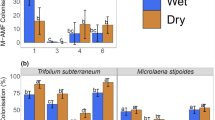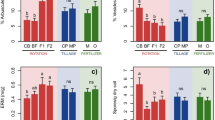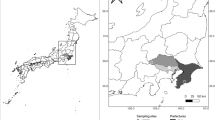Abstract
Fine root endophytes (FRE) were traditionally considered a morphotype of arbuscular mycorrhizal fungi (AMF), but recent genetic studies demonstrate that FRE belong within the subphylum Mucoromycotina, rather than in the subphylum Glomeromycotina with the AMF. These findings prompt enquiry into the fundamental ecology of FRE and AMF. We sampled FRE and AMF in roots of Trifolium subterraneum from 58 sites across temperate southern Australia. We investigated the environmental drivers of composition, richness, and root colonization of FRE and AMF by using structural equation modelling and canonical correspondence analyses. Root colonization by FRE increased with increasing temperature and rainfall but decreased with increasing phosphorus (P). Root colonization by AMF increased with increasing soil organic carbon but decreased with increasing P. Richness of FRE decreased with increasing temperature and soil pH. Richness of AMF increased with increasing temperature and rainfall but decreased with increasing soil aluminium (Al) and pH. Aluminium, soil pH, and rainfall were, in decreasing order, the strongest drivers of community composition of FRE; they were also important drivers of community composition of AMF, along with temperature, in decreasing order: rainfall, Al, temperature, and soil pH. Thus, FRE and AMF showed the same responses to some (e.g. soil P, soil pH) and different responses to other (e.g. temperature) key environmental factors. Overall, our data are evidence for niche differentiation among these co-occurring mycorrhizal associates.




Similar content being viewed by others
Data Availability
All data is available in Supporting Information and sequences have been submitted to NCBI (accession number PRJNA648786).
Abbreviations
- Al:
-
Aluminium
- AMF:
-
Arbuscular mycorrhizal fungi
- CCA:
-
Canonical correspondence analysis
- Ha:
-
Hectare
- FRE:
-
Fine root endophytes
- K:
-
Potassium
- OC:
-
Organic carbon
- OTU:
-
Operational taxonomic unit
- P:
-
Phosphorus
- pH:
-
Potential hydrogen
- SEM:
-
Structural equation model
- S:
-
Sulphur
References
Albornoz FE, Hayes PE, Orchard S, Clode PL, Nazeri N, Standish RJ, Bending GD, Hilton S, Ryan MH (2020) First cryo-scanning electron microscopy images and X-ray microanalyses of mucoromycotinian fine root endophytes in vascular plants. Front Microbiol 11:2018
Blair GJ, Chinoim N, Lefroy RDB, Anderson GC, Crocker GJ (1991) A soil sulfur test for pastures and crops. Soil Res 29:619–626
Brundrett M (2009) Mycorrhizal associations and other means of nutrition of vascular plants: understanding the global diversity of host plants by resolving conflicting information and developing reliable means of diagnosis. Plant Soil 320:37–77
Bueno de Mesquita CP, Sartwell SA, Ordemann EV, Porazinska DL, Farrer EC, King AJ, Spasojevic MJ, Smith JG, Suding KN, Schmidt SK (2018) Patterns of root colonization by arbuscular mycorrhizal fungi and dark septate endophytes across a mostly-unvegetated, high-elevation landscape. Fungal Ecol 36:63–74
Colwell JD (1963) The estimation of the phosphorus fertilizer requirements of wheat in southern New South Wales by soil analysis. Aust J Exp Agric 3:190–197
Crush JR (1973) The effect of Rhizophagus tenuis mycorrhizas on ryegrass, cocksfoot and sweet vernal. New Phytol 72:965–973
Desirò A, Rimington WR, Jacob A, Pol NV, Smith ME, Trappe JM, Bidartondo MI, Bonito G (2017) Multigene phylogeny of Endogonales, an early diverging lineage of fungi associated with plants. IMA Fungus 8:245–257
Dickie IA (2010) Insidious effects of sequencing errors on perceived diversity in molecular surveys. New Phytol 188:916–918
Dickie IA, Reich PB (2005) Ectomycorrhizal fungal communities at forest edges. J Ecol 93:244–255
Edgar RC (2004) MUSCLE: multiple sequence alignment with high accuracy and high throughput. Nucleic Acids Res 32:1792–1797
Enns JT, Ochs EP, Rensink RA (1990) VSearch: Macintosh software for experiments in visual search. Behav Res Methods Instrum Comput 22:118–122
Field KJ, Pressel S (2018) Unity in diversity: structural and functional insights into the ancient partnerships between plants and fungi. New Phytol 220:996–1011
Field KJ, Rimington WR, Bidartondo MI, Allinson KE, Beerling DJ, Cameron DD, Duckett JG, Leake JR, Pressel S (2015) First evidence of mutualism between ancient plant lineages (Haplomitriopsida liverworts) and Mucoromycotina fungi and its response to simulated Palaeozoic changes in atmospheric CO2. New Phytol 205:743–756
Field KJ, Rimington WR, Bidartondo MI, Allinson KE, Beerling DJ, Cameron DD, Duckett JG, Leake JR, Pressel S (2016) Functional analysis of liverworts in dual symbiosis with Glomeromycota and Mucoromycotina fungi under a simulated Palaeozoic CO2 decline. ISME J 10:1514–1526
Field KJ, Bidartondo MI, Rimington WR, Hoysted GA, Beerling D, Cameron DD, Duckett JG, Leake JR, Pressel S (2019) Functional complementarity of ancient plant–fungal mutualisms: contrasting nitrogen, phosphorus and carbon exchanges between Mucoromycotina and Glomeromycotina fungal symbionts of liverworts. New Phytol 223:908–921
Foster K, You MP, Nietschke B, Edwards N, Barbetti MJ (2017) Soilborne root disease pathogen complexes drive widespread decline of subterranean clover pastures across diverse climatic zones. Crop Pasture Sci 68:33–44
Fox J, Weisberg S (2019) An R companion to applied regression (third). Sage, Thousand Oaks
Fuchs B, Haselwandter K (2004) Red list plants: colonization by arbuscular mycorrhizal fungi and dark septate endophytes. Mycorrhiza 14:244–281
Göransson P, Olsson PA, Postma J, Falkengren-Grerup U (2008) Colonisation by arbuscular mycorrhizal and fine endophytic fungi in four woodland grasses - variation in relation to pH and aluminium. Soil Biol Biochem 40:2260–2265
Grace J (2006) Structural equation modeling and natural systems. Cambridge University Press, New York, NY
Hoysted GA, Kowal J, Jacob A, Rimington WR, Duckett JG, Pressel S, Orchard S, Ryan MH, Field KJ, Bidartondo MI (2018) A mycorrhizal revolution. Curr Opin Plant Biol 44:1–6
Jeffery RP, Simpson RJ, Lambers H, Orchard S, Kidd DR, Haling RE, Ryan MH (2018) Contrasting communities of arbuscule-forming root symbionts change external critical phosphorus requirements of some annual pasture legumes. Appl Soil Ecol 126:88–97
Kimura M (1980) A simple method for estimating evolutionary rate of base substitutions through comparative studies of nucleotide sequences. J Mol Evol 16:111–120
Kivlin SN, Hawkes CV, Treseder KK (2011) Global diversity and distribution of arbuscular mycorrhizal fungi. Soil Biol Biochem 43:2294–2303
Kivlin SN, Winston GC, Goulden ML, Treseder KK (2014) Environmental filtering affects soil fungal community composition more than dispersal limitation at regional scales. Fungal Ecol 12:14–25
Kline R (2016) Principles and Practice of Structural Equation Modeling, 4th edn. APA PsycNET, Washington, DC
Kowal J, Arrigoni E, Serra J, Bidartondo M (2020) Prevalence and phenology of fine root endophyte colonization across populations of Lycopodiella inundata. Mycorrhiza 30:577–587
Kumar S, Stecher G, Li M, Knyaz C, Tamura K (2018) MEGA X: molecular evolutionary genetics analysis across computing platforms. Mol Biol Evol 35:1547–1549
Lefcheck JS (2016) piecewiseSEM : piecewise structural equation modelling in r for ecology, evolution, and systematics. Methods Ecol Evol 7:573–579
Lenton TM, Crouch M, Johnson M, Pires N, Dolan L (2012) First plants cooled the Ordovician. Nat Geosci 5:86–89
McGonigle TP, Miller MH, Evans DG, Fairchild GL, Swan JA (1990) A new method which gives an objective measure of colonization of roots by vesicular—arbuscular mycorrhizal fungi. New Phytol 115:495–501
Nichols PG, Loi A, Nutt BJ, Evans PM, Craig AD, Pengelly BC, Dear BS, Lloyd DL, Revell CK, Nair RM, Ewing MA (2007) New annual and short-lived perennial pasture legumes for Australian agriculture—15 years of revolution. Field Crop Res 104:10–23
Oksanen J, Blanchet FG, Friendly M, et al (2017) Vegan: community ecology package. R package version 2.3-0;2015. http://CRAN.R-project.org/package=vegan. Accessed Sept 2020
Olsson PA, Eriksen B, Dahlberg A (2004) Colonization by arbuscular mycorrhizal and fine endophytic fungi in herbaceous vegetation in the Canadian High Arctic. Can J Bot 82:1547–1556
Öpik M, Davison J, Moora M, Zobel M (2014) DNA-based detection and identification of Glomeromycota: the virtual taxonomy of environmental sequences. Botany 92:135–147
Orchard S, Standish RJ, Nicol D, Gupta VV, Ryan MH (2016) The response of fine root endophyte (Glomus tenue) to waterlogging is dependent on host plant species and soil type. Plant Soil 403:305–315
Orchard S, Hilton S, Bending GD, Dickie IA, Standish RJ, Gleeson DB, Jeffery RP, Powell JR, Walker C, Bass D, Monk J (2017a) Fine endophytes (Glomus tenue) are related to Mucoromycotina, not Glomeromycota. New Phytol 213:481–486
Orchard S, Standish RJ, Dickie IA, Renton M, Walker C, Moot D, Ryan MH (2017b) Fine root endophytes under scrutiny: a review of the literature on arbuscule-producing fungi recently suggested to belong to the Mucoromycotina. Mycorrhiza 27:619–638
Orchard S, Standish RJ, Nicol D, Dickie IA, Ryan MH (2017c) Sample storage conditions alter colonisation structures of arbuscular mycorrhizal fungi and, particularly, fine root endophyte. Plant Soil 412:35–42
Ormsby A, Hodson E, Li Y, Basinger J, Kaminskyj S (2007) Quantitation of endorhizal fungi in High Arctic tundra ecosystems through space and time: the value of herbarium archives. NRC Res Press 85:599–606
Piano E, Pecetti L, Carroni AM (1996) Climatic adaptation in subterranean clover populations. Euphytica 92:39–44
Postma JWM, Olsson PA, Falkengren-Grerup U (2007) Root colonisation by arbuscular mycorrhizal, fine endophytic and dark septate fungi across a pH gradient in acid beech forests. Soil Biol Biochem 39:400–408
Quast C, Pruesse E, Yilmaz P, et al (2012) The SILVA ribosomal RNA gene database project: improved data processing and web-based tools. Nucleic Acids Res 41, D590–D596. academic.oup.com
Rayment GE, Lyons DJ (2012) New, comprehensive soil chemical methods book for Australasia. Commun Soil Sci Plant Anal 43:412–418
Ryan MH, Ash JE (1996) Colonisation of wheat in southern New South Wales by vesicular-arbuscular mycorrhizal fungi is significantly reduced by drought. Aust J Exp Agric 36:563–569
Ryan MH, Kirkegaard JA (2012) The agronomic relevance of arbuscular mycorrhizas in the fertility of Australian extensive cropping systems. Agric Ecosyst Environ 163:37–53
Sato K, Suyama Y, Saito M, Sugawara K (2005) A new primer for discrimination of arbuscular mycorrhizal fungi with polymerase chain reaction-denature gradient gel electrophoresis. Grassl Sci 51:179–181
Smith SE, Read DJ (2008) Mycorrhizal symbiosis (third). Academic press, London
Strullu-Derrien C, Selosse MA, Kenrick P, Martin FM (2018) The origin and evolution of mycorrhizal symbioses: from palaeomycology to phylogenomics. New Phytol 220:1012–1030
Ter Braak CJ (1986) Canonical correspondence analysis: a new eigenvector technique for multivariate direct gradient analysis. Ecology 67:1167–1179
Thippayarugs S, Bansal M, Abbott LK (1999) Morphology and infectivity of fine endophyte in a Mediterranean environment. Mycol Res 103:1369–1379
Vierheilig H, Coughlan AP, Wyss U, Piché Y (1998) Ink and vinegar, a simple staining technique for arbuscular-mycorrhizal fungi. Appl Environ Microbiol 64:5004–5007
Walker XJ, Basinger JF, Kaminskyj SG (2010) Endorhizal fungi in Ranunculus from western and arctic Canada: predominance of fine endophytes at high latitudes. Open Mycol J 4:1–9
Walkley A, Black IA (1934) An examination of the Degtjareff method for determining soil organic matter, and a proposed modification of the chromic acid titration method. Soil Sci 37:29–38
Wang W, Shi J, Xie Q, Jiang Y, Yu N, Wang E (2017) Nutrient exchange and regulation in arbuscular mycorrhizal symbiosis. Mol Plant 10:1147–1158
R Core Team 2016 R: A Language and Environment for Statistical Computing. Vienna, Austria: R Foundation for Statistical Computing. https://www.R-project.org/. Accessed Sept 2020
Acknowledgements
This research was initiated through a project funded by an Australian Government Postgraduate Award, a Meat and Livestock Australia Postgraduate Scholarship and a Henry Schapper Postgraduate Research Scholarship to SO. We also thank the many woolgrowers across southern Australia who assisted with sampling of their farms.
Funding
The research was subsequently funded by an Australian Research Council (ARC) Discovery grant (DP180103157) and the Natural Environment Research Council NE/S010270/1. MHR was funded by an ARC Future Fellowship (FT140100103). Provision of field samples and associated background data were funded through Australian Wool Innovation Ltd., project ON-279 ‘Making clover pastures permanently resistant to Phytophthora root disease’.
Author information
Authors and Affiliations
Contributions
SO and KJF conducted the sampling, carried out the glasshouse conditioning, and processed samples for analyses. MPY and MJB supplied revised environmental datasets for field pasture samples taken across southern Australia. DBG contributed to DNA sampling and extraction and liaised with GDB and SH who conducted all the molecular and bioinformatics work, and constructed the phylogenetic tree. MHR, RJS, and IAD provided supervision of SO during her Ph.D as well as statistical advice to FEA. FEA analysed the data. FEA, RJS, and MHR wrote the manuscript. All authors contributed to the manuscript by providing feedback and/or written content.
Corresponding author
Ethics declarations
Conflict of Interest
The authors declare that they there is no conflict of interest.
Code Availability
Code will not be made publicly available.
Electronic supplementary material
ESM 1
(DOCX 1593 kb)
Rights and permissions
About this article
Cite this article
Albornoz, F.E., Orchard, S., Standish, R.J. et al. Evidence for Niche Differentiation in the Environmental Responses of Co-occurring Mucoromycotinian Fine Root Endophytes and Glomeromycotinian Arbuscular Mycorrhizal Fungi. Microb Ecol 81, 864–873 (2021). https://doi.org/10.1007/s00248-020-01628-0
Received:
Accepted:
Published:
Issue Date:
DOI: https://doi.org/10.1007/s00248-020-01628-0




